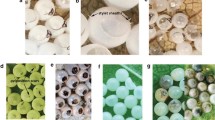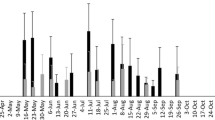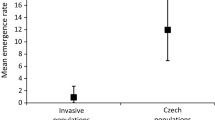Abstract
Since the establishment of the brown marmorated stink bug, Halyomorpha halys (Stål) (Hemiptera: Pentatomidae) in North America and Europe, there has been a large, multi-group effort to characterize the composition and impact of the indigenous community of arthropod natural enemies attacking this invasive pest. In this review, we combine 98 indigenous natural enemy datasets spanning a variety of sampling methods, habitats, and geographic areas. To date, the vast majority of H. halys biological control research has focused on the egg stage, using sentinel egg masses to characterize indigenous parasitoid and predator communities and their contribution to H. halys egg mortality. Although egg parasitism and predation levels by indigenous natural enemies are low (typically <10% each) in most surveys, total egg mortality attributable to natural enemies can be higher (typically between 5 and 25%; up to 83%)—even though these values were likely underestimated in most cases because some mortality due to biological control was not recognized. In North America, where the most data are available, it appears that the relative prevalence of different indigenous parasitoid species varies among habitat types, particularly between crop and non-crop habitats. Predator species responsible for egg mortality are much less commonly identified, but appear to include a wide variety of generalist chewing and sucking predators. To date, studies of natural enemies attacking H. halys nymphs and adults are relatively rare. Based on our review, we identify a number of key research gaps and suggest several directions for future research.



Similar content being viewed by others
References
Abram PK, Gariepy TD, Boivin G, Brodeur J (2014) An invasive stink bug as an evolutionary trap for an indigenous egg parasitoid. Biol Invasion 16:1387–1395
Abram PK, Doyon J, Brodeur J, Gariépy TD, Boivin G (2015) Susceptibility of Halyomorpha halys (Hemiptera: Pentatomidae) eggs to different life stages of three generalist predators. Can Entomol 147:222–226
Abram PK, Brodeur J, Burte V, Boivin G (2016) Parasitoid-induced host egg abortion: an underappreciated component of biological control services provided by egg parasitoids. Biol Control 98:52–60
Aldrich JR, Khrimian A, Zhang A, Shearer PW (2006) Bug pheromones (Hemiptera, Heteroptera) and tachinid fly host-finding. Denisia 19:1015–1031
Bellows TS, Van Driesche RG (1999) Life table construction and analysis for evaluating biological control agents. In: Bellows TS, Fisher TW (eds) Handbook of biological control, pp 199–203
Berthon K (2015) How do native species respond to invaders? Mechanistic and trait-based perspectives. Biol Invasion 17:2199–2211
Biddinger DJ, Surcică A, Joshi NK (2017) A native predator utilizing the invasive brown marmorated stink bug, Halyomorpha halys (Hemiptera: Pentatomidae) as a food source. Biocontrol Sci Technol (in press)
Blaauw BR, Polk D, Nielsen AL (2015) IPM-CPR for peaches: incorporating behaviorally-based methods to manage Halyomorpha halys and key pests in peach. Pest Manag Sci 71:1513–1522
Conti E, Colazza S (2012) Chemical ecology of egg parasitoids associated with true bugs. Psyche. doi:10.1155/2012/651015
Cornelius ML, Dieckhoff C, Vinyard BT, Hoelmer KA (2016a) Parasitism and predation on sentinel egg masses of the brown marmorated stink bug (Hemiptera: Pentatomidae) in three vegetable crops: importance of dissections for evaluating the impact of native parasitoids on an exotic pest. Environ Entomol 45:1536–1542
Cornelius ML, Dieckhoff C, Hoelmer KA, Olsen RT, Weber DC, Herlihy MV, Talamas EJ, Vinyard BT, Greenstone MH (2016b) Biological control of sentinel egg masses of the exotic invasive stink bug Halyomorpha halys (Stål) in Mid-Atlantic USA ornamental landscapes. Biol Control 103:11–20
Cornell HV, Hawkins BA (1993) Accumulation of native parasitoid species on introduced herbivores: a comparison of hosts as natives and hosts as invaders. Am Nat 141:847–865
Cusumano A, Peri E, Amodeo V, McNeil JN, Colazza S (2013) Intraguild interactions between egg parasitoids: window of opportunity and fitness costs for a facultative hyperparasitoid. PLoS ONE 8:e64768
Dieckhoff C, Tatman K, Hoelmer KA (2017) Natural biological control of Halyomorpha halys by native egg parasitoids—a multi-year survey in northern Delaware. J Pest Sci. doi:10.1007/s10340-017-0868-6
Elkinton JS, Buonaccorsi JP, Bellows TS, Van Driesche RG (1992) Marginal attack rate, k-values and density dependence in the analysis of contemporaneous mortality factors. Res Popul Ecol 34:29–44
Field SA (1998) Patch exploitation, patch-leaving and pre-emptive patch defence in the parasitoid wasp Trissolcus basalis (Insecta: Scelionidae). Ethology 104:323–338
Fraga DF, Parker J, Busoli AC, Hamilton GC, Nielsen AL, Rodriguez-Saona C (2017) Behavioral responses of predaceous minute pirate bugs to tridecane, a volatile emitted by the brown marmorated stink bug. J Pest Sci. doi:10.1007/s10340-016-0825-9
Gardiner MM, Landis DA, Gratton C, DiFonzo CD, O’Neal M, Chacon JM, Wayo MT, Schmidt NP, Mueller EE, Heimpel GE (2009) Landscape diversity enhances biological control of an introduced crop pest in the north-central USA. Ecol Appl 19:143–154
Gariepy TD, Haye T, Zhang J (2014) A molecular diagnostic tool for the preliminary assessment of host–parasitoid associations in biological control programmes for a new invasive pest. Mol Ecol 23:3912–3924
Haye T, Gariepy T, Hoelmer K, Rossi JP, Streito JC, Tassus X, Desneux N (2015a) Range expansion of the invasive brown marmorated stinkbug, Halyomorpha halys: an increasing threat to field, fruit and vegetable crops worldwide. J Pest Sci 88:665–673
Haye T, Fischer S, Zhang J, Gariepy TD (2015b) Can native egg parasitoids adopt the invasive brown marmorated stink bug, Halyomorpha halys (Heteroptera: Pentatomidae), in Europe? J Pest Sci 88:693–705
Hedstrom CH, D Lowenstein, H Andrews, B Bai, and NG Wiman (2017) Pentatomid host suitability and the discovery of introduced populations of Trissolcus japonicus in Oregon. J Pest Sci. doi:10.1007/s10340-017-0892-6
Heimpel GE, Neuhauser C, Hoogendoorn M (2003) Effects of parasitoid fecundity and host resistance on indirect interactions among hosts sharing a parasitoid. Ecol Lett 6:556–566
Herlihy MV, Talamas EJ, Weber DC (2016) Attack and success of native and exotic parasitoids on eggs of Halyomorpha halys in three Maryland habitats. PLoS ONE 11:e0150275
Johnson N (1984) Systematics of Nearctic Telenomus: classification and revisions of the podisi and phymatae species groups (Hymenoptera: Scelionidae). Bull Ohio Biol Surv 6:1–112
Johnson N (1987) Systematics of New World Trissolcus, a genus of pentatomid egg-parasites (Hymenoptera: Scelionidae): Neotropical species of the flavipes group. J Nat Hist 21:285–304
Jones A (2013) Indigenous natural enemies of the invasive brown marmorated stink bug, Halyomorpha halys (Hemiptera: Pentatomidae). Department of Entomology, University of Maryland, College Park, Master of Science, p 62
Jones AL, Jennings DE, Hooks CRR, Shrewsbury PM (2014) Sentinel eggs underestimate rates of parasitism of the exotic brown marmorated stink bug, Halyomorpha halys. Biol Control 78:61–66
Konopka JK, Haye T, Gariepy T, Mason PG, Gillespie DR, McNeil JN (2017a) An exotic parasitoid provides an invasional lifeline for native parasitoids. Ecol Evol 7:277–284
Konopka JK, Haye T, Gariepy TD, McNeil JN (2017b) Possible coexistence of native and exotic parasitoids and their impact on control of Halyomorpha halys. J Pest Sci. doi:10.1007/s10340-017-0851-2
Kuhar TP, Kamminga K (2017) Review of the chemical control research on Halyomorpha halys in the United States. J Pest Sci. doi:10.1007/s10340-017-0859-7
Kuhar TP, Short BD, Krawczyk G, Leskey TC (2017) Deltamethrin-incorporated nets as an integrated pest management tool for the invasive Halyomorpha halys (Hemiptera: Pentatomidae). J Econ Entomol. doi:10.1093/jee/tow321
Lara R, Pickett C, Ingels C, Haviland DR, Grafton-Cardwell E, Doll D, Bethke J, Faber B, Dara SK, Hoddle M (2016) Biological control program is being developed for brown marmorated stink bug. Calif Agric 70:15–23
Leskey TC, Short BD, Butler BR, Wright SE (2012) Impact of the invasive brown marmorated stink bug, Halyomorpha halys (Stål), in mid-Atlantic tree fruit orchards in the United States: case studies of commercial management. Psyche. doi:10.1155/2012/535062
MacFadyen S, Davies AP, Zalucki MP (2015) Assessing the impact of arthropod natural enemies on crop pests at the field scale. Insect Sci 22:20–34
Mathews CR, Blaauw B, Dively G, Kotcon J, Moore J, Ogburn E, Pfeiffer DG, Trope T, Walgenbach JF, Welty C, Zinati G, Nielsen AL (2017) Evaluating a polyculture trap crop for organic management of Halyomorpha halys and native stink bugs in peppers. J Pest Sci. doi:10.1007/s10340-017-0838-z
Milnes JM, Wiman NG, Talamas EJ, Brunner JF, Hoelmer KA, Buffington ML, Beers EH (2016) Discovery of an exotic egg parasitoid of the brown marmorated stink bug, Halyomorpha halys (Stål) in the Pacific Northwest. Proc Entomol Soc Wash 118:466–470
Morrison WR III, Mathews CR, Leskey TC (2016a) Frequency, efficiency, and physical characteristics of predation by generalist predators of brown marmorated stink bug (Hemiptera: Pentatomidae) eggs. Biol Control 97:120–130
Morrison WR III, Park C-G, Seo BY, Park Y-L, Kim HG, Rice KB, Lee D-H, Leskey TC (2016b) Attraction of the invasive Halyomorpha halys in its native Asian range to traps baited with semiochemical stimuli. J Pest Sci. doi:10.1007/s10340-016-0816-x
Morrison WR III, Lee DH, Short BD, Khrimian A, Leskey TC (2016c) Establishing the behavioral basis for an attract-and-kill strategy to manage the invasive Halyomorpha halys in apple orchards. J Pest Sci 89:81–96
Morrison WR III, Bryant AN, Poling B, Quinn NF, Leskey TC (2017) Predation of Halyomorpha halys (Hemiptera: Pentatomidae) from web-building spiders associated with anthropogenic dwellings. J Insect Behav 30:70–85
Noyes JS (2017) Universal Chalcidoidea Database. World Wide Web electronic publication. http://www.nhm.ac.uk/chalcidoids. Accessed 30 Mar 2017
Ogburn EC, Bessin R, Dieckhoff C, Dobson R, Grieshop M, Hoelmer KA, Matthews C, Moore J, Nielsen AL, Poley K, Pote JM, Rogers M, Welty C, Walgenbach JF (2016) Natural enemy impact on eggs of the invasive brown marmorated stink bug, Halyomorpha halys (Stål)(Hemiptera: Pentatomidae), in organic agroecosystems: a regional assessment. Biol Control 101:39–51
Okuda MS, Yeargan KV (1988) Habitat partitioning by Telenomus podisi and Trissolcus euschisti (Hymenoptera: Scelionidae) between herbaceous and woody host plants. Environ Entomol 17:795–798
Rice KB, Bergh CJ, Bergmann EJ, Biddinger DJ, Dieckhoff C, Dively G, Fraser H, Gariepy TD, Hamilton G, Haye T, Herbert A, Hoelmer KA, Hooks CR, Jones A, Krawczyk G, Kuhar T, Martinson H, Mitchell W, Nielsen AL, Pfeiffer DG, Raupp M, Rodrigues-Saona C, Shearer P, Shrewsbury P, Venugopal PD, Whalen J, Wiman NG, Leskey TC, Tooker JF (2014) Biology, ecology, and management of brown marmorated stink bug (Hemiptera: Pentatomidae). J Integr Pest Manag 5:A1–A13
Rondoni G, Bertoldi V, Malek R, Foti MC, Peri E, Maistrello L, Haye T, Conti E (2017) Native egg parasitoids recorded from the invasive Halyomorpha halys successfully exploit volatiles emitted by the plant–herbivore complex. J Pest Sci. doi:10.1007/s10340-017-0861-0
Rosenheim JA, Kaya HK, Ehler LE, Marois JJ, Jaffee BA (1995) Intraguild predation among biological-control agents: theory and evidence. Biol Control 5:303–335
Roversi PF, Binazzi F, Marianelli L, Costi E, Maistrello L, Sabbatini Peverieri G (2016) Searching for native egg-parasitoids of the invasive alien species Halyomorpha halys Stål (Heteroptera, Pentatomidae) in Southern Europe. Redia 99:63–70. doi:10.19263/REDIA-99.16.01
Schlaepfer MA, Sherman PW, Blossey B, Runge MC (2005) Introduced species as evolutionary traps. Ecol Lett 8:241–246
Strayer DL, Eviner VT, Jeschke JM, Pace ML (2006) Understanding the long-term effects of species invasions. TREE 21:645–651
Talamas EJ, Herlihy MV, Dieckhoff C, Hoelmer KA, Buffington M, Bon M-C, Weber DC (2015) Trissolcus japonicus (Ashmead)(Hymenoptera, Scelionidae) emerges in North America. J Hymenopt Res 43:119–128
Tognon R, SantAna J, Zhang QH, Millar JG, Aldrich JR, Zalom FG (2016) Volatiles mediating parasitism of Euschistus conspersus and Halyomorpha halys eggs by Telenomus podisi and Trissolcus erugatus. J Chem Ecol 42:1016–1027
Tschorsnig HP, Herting B (1994) The tachinids (Diptera: Tachinidae) of central Europe: identification keys for the species and data on distribution and ecology. Stuttgarter Beiträge zur Naturkunde, Serie A (Biol.), p 150
Van Driesche RG (1983) Meaning of “percent parasitism” in studies of insect parasitoids. Environ Entomol 12:1611–1622
Weber DC, Morrison WR III, Khrimian A, Rice K, Leskey TC, Rodriguez-Saona C, Nielsen AL, Blaauw BR (2017) Chemical ecology of Halyomorpha halys: discoveries and applications. J Pest Sci. doi:10.1007/s10340-017-0876-6
Yang ZQ, Yao YX, Qiu LF, Li ZX (2009) A new species of Trissolcus (Hymenoptera: Scelionidae) parasitizing eggs of Halyomorpha halys (Heteroptera: Pentatomidae) in China with comments on its biology. Ann Entomol Soc Am 102:39–47
Zhang J, Zhang F, Gariepy T, Mason P, Gillespie D, Talamas E, Haye T (2017) Seasonal parasitism and host specificity of Trissolcus japonicus in northern China. J Pest Sci. doi:10.1007/s10340-017-0863-y
Acknowledgements
The authors wish to thank the following for research assistance collecting data used in this review: Clint Fleshman, Dana Martin, Chad Kramer, Lindsay Stump, Chelsea Berish, Sarah Detraz, Waydon Yates, the UKY farm crew, Emma Thrift, Treva Rowley, Nathan Erwin, Rose Borror, Zachary Johnson, Heather Leach, Megan Lowlor, Brooke Merrill, Devon Newsom, Gary Parason, Ryan Paul, Trisha Samota, McKenzie Allen, Brittany Poling, Morgan Douglas, Samuel Brandt, Torri Hancock, John Cullum, Adam Cave, Tina Dancau, Dennis Quach, Chris Hughes, Lot Miller, Kathy Wholaver, Katy Ellis, Silvia T. Moraglio, Marco G. Pansa, Kathy Tatman, Kylie Mendonca, Kody Transue, Max Sinton, Andrew Lyons, Elizabeth Fread, Abigail Rosenburg, Jeremy Turner, and Steve Schoof. We thank the following grower cooperators: Jeff Dickinson, Mike Laughlin, Sue Borton, Guy Ashmore, Redbud Farm, Barry Rice, and Scott Slaybaugh. Funding for the work synthesized in this review includes grants from the USDA-NIFA-OREI No. 2012-51300-20097; USDA-NIFA-SCRI Nos. 2011-51181-30937; USDA NE-1032 Multistate Hatch Project; Federally funded Specialty Crop Block Grant 13054, administered by the California Department of Food & Agriculture; State Horticultural Association of Pennsylvania; Pennsylvania State University Hatch Project No. Pen04619. The USDA does not endorse any commercial product mentioned in this research. USDA is an equal opportunity provider and employer.
Author information
Authors and Affiliations
Corresponding author
Ethics declarations
Conflict of interest
The authors have declared that no conflict of interest exists.
Ethical approval
All applicable international, national, and/or institutional guidelines for the care and use of animals were followed. This article does not contain any studies with human participants performed by any of the authors.
Additional information
Communicated by M. Traugott.
Special Issue: The brown marmorated stink bug Halyomorpha halys an emerging pest of global concern.
Electronic supplementary material
Below is the link to the electronic supplementary material.
Rights and permissions
About this article
Cite this article
Abram, P.K., Hoelmer, K.A., Acebes-Doria, A. et al. Indigenous arthropod natural enemies of the invasive brown marmorated stink bug in North America and Europe. J Pest Sci 90, 1009–1020 (2017). https://doi.org/10.1007/s10340-017-0891-7
Received:
Revised:
Accepted:
Published:
Issue Date:
DOI: https://doi.org/10.1007/s10340-017-0891-7




